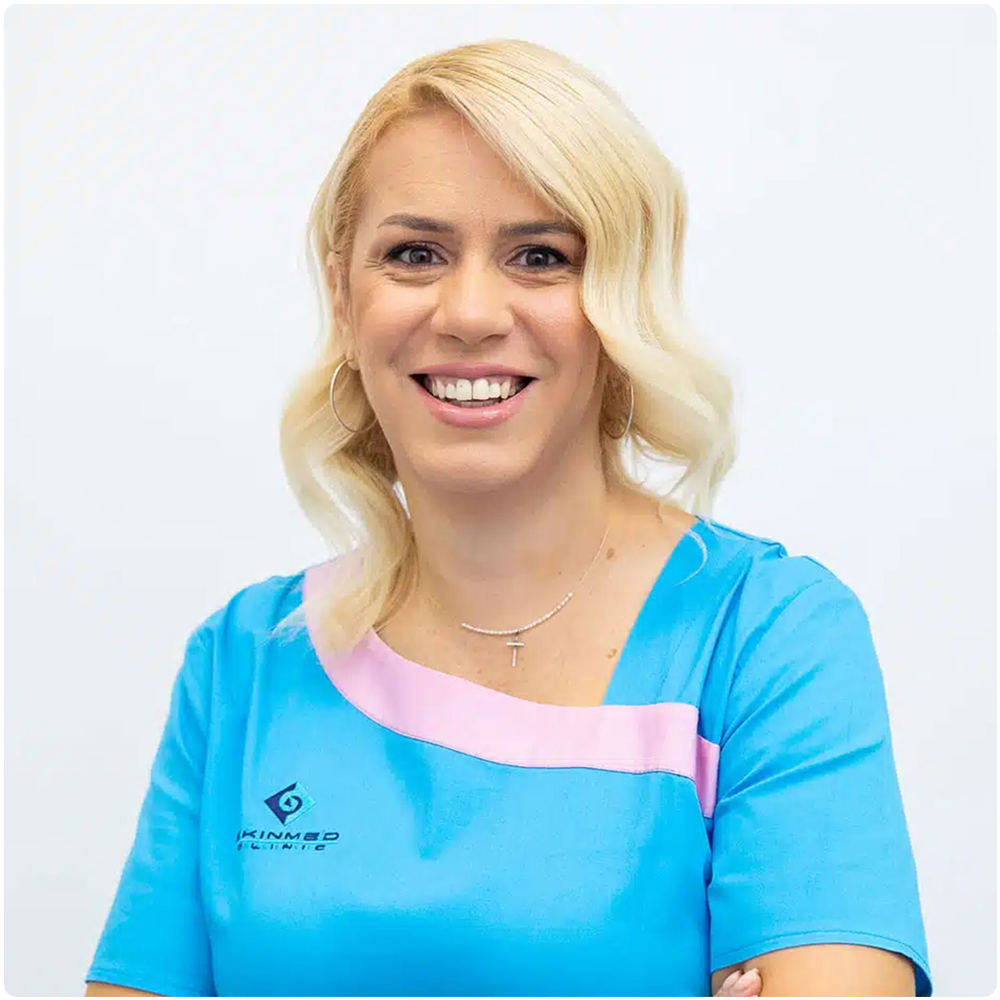Chemical peels are extremely valuable procedures, both therapeutically and aesthetically.
Chemical peels
Who are we talking to?
To all those who need accelerated skin regeneration in a controlled way. Chemical peels are recommended for people who want to improve the texture, brightness and evenness of their skin. They are also useful for treating acne, pigmentation spots, scars or fine wrinkles. Chemical peels remove dead skin cells from the surface of the skin so that fresh, healthy skin can emerge.
Why choose SKINMED® experts?
SKINMED® experts have extensive experience in minimally invasive aesthetic treatments and are constantly in touch with the latest national and international information on new treatments and technologies. It is important that the chemical peel is carried out in a medical clinic and not in a cosmetic salon, because the medical staff can adapt the composition of the peel and the duration of application to your needs, can immediately notice any side effects and remedy them.
Benefits of chemical peels in SKINMED®
variety of peels available
healing period 1-5 days (superficial peeling)
recovery leave for a few days (deep peeling)
post-procedure care treatment
firm skin, natural look
What does chemical peeling involve?
Chemical peeling (also called derma-peeling or chemo-exfoliation) involves the application of chemical exfoliating agents that act on the different layers of the skin. Controlled exfoliation allows tissue regeneration, resulting in smoother, firmer and healthier skin and stimulates the production of collagen, elastin and glycosaminoglycans.
It is important to consult a dermatologist before attempting a chemical peel, as factors such as medical history, skin type and other medical conditions may influence the decision to have such a treatment. It is also important to follow skin care instructions strictly after a chemical peel to avoid adverse reactions or skin irritation.
Types of chemical peels
Depending on the depth at which they work, chemical peels can be divided into 3 categories:
Superficial:
acts on the superficial layer of the skin and stimulates epidermis growth by removing the horny layer. The procedure takes 30 minutes and is recommended from September to the end of April, once a month. Recovery time after superficial chemical peeling is 2-3 days.
Medium (papillary dermis):
acts down to the papillary dermis, causing significant desquamation by inducing superficial dermal inflammation. A session lasts 45 minutes and is recommended to be repeated every 5 weeks.
deep chemical exfoliation, which causes an inflammatory reaction in the reticular dermis and thus induces the rebuilding of collagen and elastin fibres.
The procedure takes about 1h and the recovery period is between 2-4 weeks. Because of potential side effects, both local and systemic, the use of deep peeling is much reduced, and is being abandoned in favour of laser procedures, which have a similar effect and no risks.
REJUVENATION AND REVITALISATION WITH PRX-T33
A special type of peel recommended by SKINMED® experts is PRX-T33, the non-invasive, non-ablative, painless, non-photosensitizing, highly effective peel treatment for biorevitalizing skin that requires no recovery time. More information, on the Chemical peeling.
Doctors EXPERT in chemical peels
In SKINMED®, you will find highly experienced medical specialists working with the latest results of medical research on prevention and treatment, using state-of-the-art medical equipment and products. We look forward to meeting our doctors for a treatment tailored to your needs!
SKINMED experience and technology®, for flawless looking skin!
Advantages SKINMED®
Experience
- Over 19,000 patients treated in the clinic
- Over 300 new patients every month
- Over 20000 treatments per year
Credits
- FOTOFINDER-accredited Centre of Expertise in the Diagnosis and Treatment of Skin Cancer
- ALMA LASER accredited laser treatment centre of expertise
- ALLERGAN accredited centre of expertise in Aesthetics and Medical Injecology
Safety
- Technologies top accredited worldwide
Other treatments you might be interested in
Frequently asked questions
How do chemical peels work and which skin types are they for?
A chemical peel is a cosmetic dermatology procedure used to improve the appearance of the skin on the face, neck and hands. Substances are applied to the skin that produce a controlled injury causing layers of skin to be exfoliated and peeled away. The regenerated skin is smoother, with improved aesthetic appearance.
When are chemical peels used?
They are used in the treatment of: wrinkles and fine lines, photoageing, uneven pigmentation of the face (melasma, ephelides), postacneal/postvaricose scars.
How many sessions will I need?
Usually 4-6 sessions are required, at 4 week intervals, for optimal results, during the initial consultation with the dermatologist, he will determine the treatment protocol depending on the problem treated and its severity.
How does a chemical peel work?
The meeting lasts 30 minutes. Before applying the peel, careful cleansing and degreasing with alcohol or acetone solutions is necessary. The chemical peel is applied. Depending on the agent used and the desired results the exposure time varies. Until the peel is neutralised, patients may feel a slight burning or stinging sensation but this is normal and not a complication of the procedure. An emollient, healing cream is applied at the end.
How to care for the skin after chemical peels?
After the procedure, use the treatment recommended by the dermatologist (a combination of scar creams and photoprotection).
What treatments can chemical peels be combined with?
Due to its effectiveness in activating the skin's own regenerative processes, chemical peeling is an ideal adjuvant treatment to other aesthetic medicine treatments. Used in combination with procedures such as CO₂ laser, microplasma radiofrequency, hybrid laser, mesotherapy, fillets, wires, own plasma therapy, etc., they act synergistically, enhancing treatment results.
The latest approach to aesthetic medicine is combination treatments. No single technique can completely address and solve all of a patient's problems. Therefore, the combination of chemical, physical or mechanical stimulation according to a well-established protocol is often the best way towards a holistic approach to achieve a natural look.
The main benefits of this procedure
- purifies and oxygenates the skin, leaving it hydrated and free of impurities;
- closes pores, improves skin texture and increases epidermis thickness;
- addresses the effects of skin ageing, diminishing wrinkles and adding plumpness;
- evens out skin tone, brightens and diminishes skin imperfections;
- brightens and fades pigmented lesions with a depigmenting effect;
- reduces clinical manifestations of acne and relieves scarring






